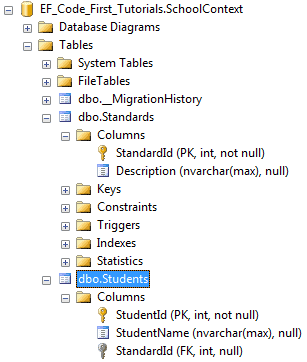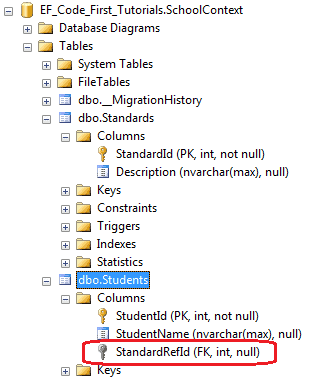DataAnnotations - ForeignKey Attribute:
ForeignKey attribute can be applied to properties of a class. Default Code-First convention for ForeignKey relationship expects foreign key property name match with primary key property.
Consider the following example.
public class Student { public Student() { } public int StudentID { get; set; } public string StudentName { get; set; } //Foreign key for Standard public int StandardId { get; set; } public Standard Standard { get; set; } } public class Standard { public Standard() { } public int StandardId { get; set; } public string StandardName { get; set; } public ICollection<Student> Students { get; set; } }
As you can see in the above code, Student class includes foreign key StandardId, which is key property in Standard class. So now, Code First will create StandardId column in Students class as shown below.
ForeignKey attribute overrides this convention. You can have a different name of a foreign key property name than the primary key of a dependent class.
public class Student { public Student() { } public int StudentID { get; set; } public string StudentName { get; set; } //Foreign key for Standard public int StandardRefId { get; set; } [ForeignKey("StandardRefId")] public Standard Standard { get; set; } } public class Standard { public Standard() { } public int StandardId { get; set; } public string StandardName { get; set; } public ICollection<Student> Students { get; set; } }
As you can see in the above example, Student class includes StandardRefId foreign key property name instead of StandardId. We specify it using ForeignKey attribute on Standard navigation property so that Code-First will consider StandardRefId as foreign key, as shown below.
ForeignKey attribute can be applied to key property to specify which navigation property it points to, as shown below.
public class Student { public Student() { } public int StudentID { get; set; } public string StudentName { get; set; } //Foreign key for Standard [ForeignKey("Standard")] public int StandardRefId { get; set; } public Standard Standard { get; set; } } public class Standard { public Standard() { } public int StandardId { get; set; } public string StandardName { get; set; } public ICollection<Student> Students { get; set; } }
Thus, you can use ForeignKey attribute to give a different name to a foreign key property.

